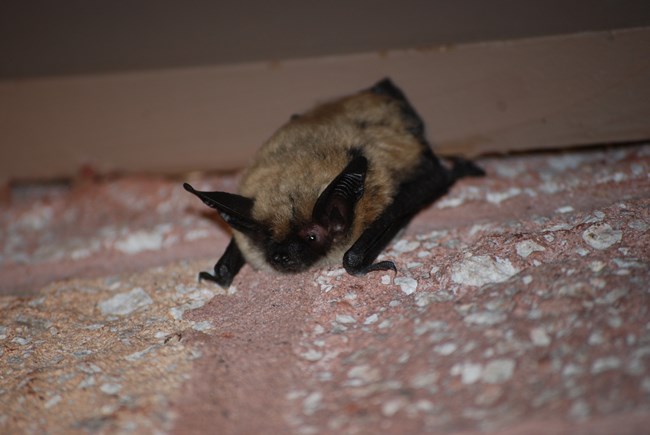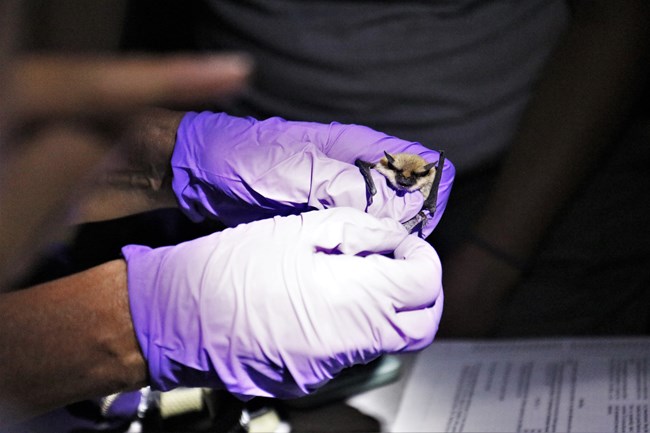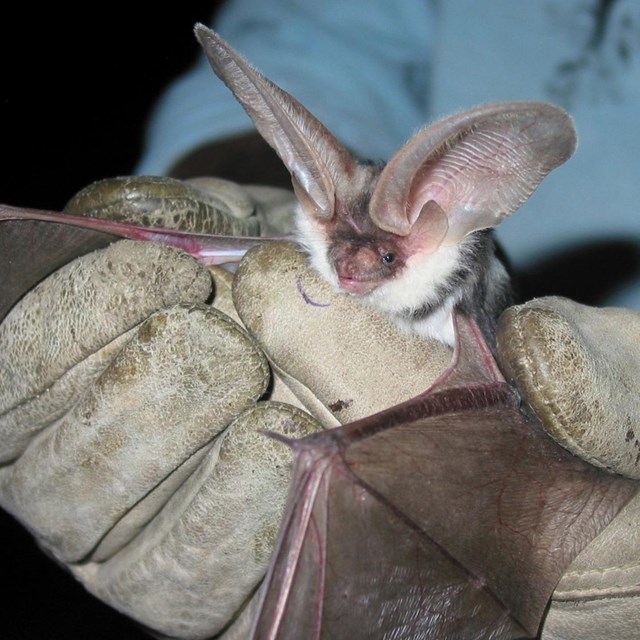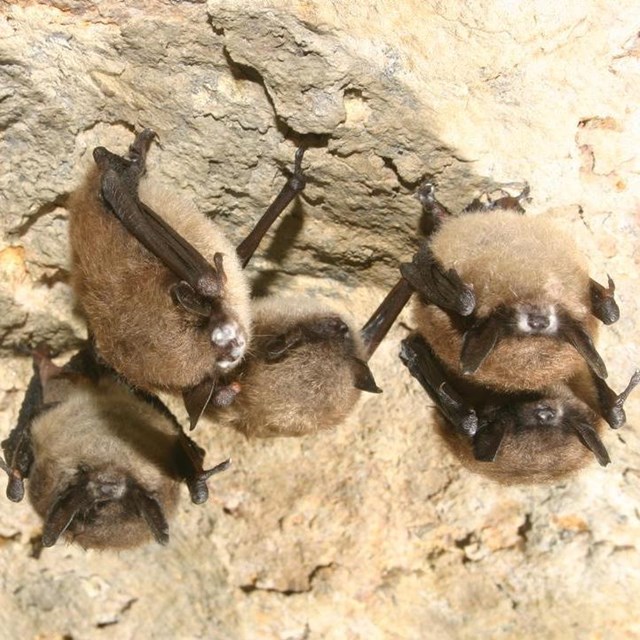Last updated: November 4, 2023
Article
Bats at Craters of the Moon

NPS Photo
The many hundreds of caves at Craters of the Moon provide important habitat for bats to roost, raise young, and hibernate. Bats are a critical ecological component of both the subterranean and surface environments in and around the park. Despite fear and stigma surrounding these winged mammals, bats in this region feed primarily on insects and help to keep mosquitoes and agricultural pests in check.
Eleven species have been documented in the park, and as many as five others may occur here. Species have been documented close enough to likely occur here or the park is within the species' known range.
Research and Monitoring
Bats may be some of the most interesting and mysterious animals found at Craters of the Moon, and park biologists and researchers are working to learn more about them. Surveys and monitoring are helping us to better identify populations of bats in the park, to determine which species are hibernating or raising young here, and to discover which of Craters' hundreds of caves are being used by bats!
A five year (2013-2017) study of hibernacula (caves used by bats for hibernation) confirmed 17 of these sites at Craters! The study found that over 50% of caves deemed suitable for hibernation were used by bats (in at least one out of 5 years). 75% of the hibernating bats found were Townsend's big-eared bats (Corynorhinus townsendii). The second most common hibernating species was the western small-footed myotis (Myotis ciliolabrum).
A 2018 study (Call, et al.) of Townsend's big-eared bats found that the majority (64%) of documented and potential caves used as maternity roosts in southern Idaho were located within Craters of the Moon!
In 2019, park biologists monitored 20 caves in Craters of the Moon during the maternity season, installing temperature and humidity data loggers prior to the bats' arrival, collecting guano (bat feces), and placing acoustic detectors at cave entrances. Because many similar species of bats are difficult or impossible to identify by sight, guano and acoustic data are useful to researchers for determining which species are present. Biologists also conducted two nights of out-flight surveys at cave entrances to help approximate colony sizes. Surveys confirmed the continued presence of three maternity colonies of Townsend's big-eared bat and western small-footed myotis, and they found three new maternity colonies (likely western small-footed myotis) not previously detected at Craters!

NPS Photo
Which Bats Hibernate at Craters?
- Townsend's big-eared bat (Corynorhinus townsendii)
- western small-footed myotis (Myotis ciliolabrum)
- little brown myotis (Myotis lucifugus)
- long-eared myotis (Myotis evotis)
- big brown bat (Eptesicus fuscus)
- Yuma myotis (Myotis yumanensis)
- California myotis (Myotis californicus) are also suspected to hibernate here
Several other hibernating species have been documented in the park, including:
- long-legged myotis (Myotis volans)
- fringed myotis (Myotis thysanodes)
- pallid bat (Antrozous pallidus)
The canyon bat, or western pipistrelle (Parastrellus Hesperus), has been documented near Burley and is likely present in the Wapi lava field (Munts 2011). Hibernacula for these species have not been identified due to the lack of survey information and/or the difficulty in identification without handling. There are no records of the spotted bat (Euderma maculatum) however, the park lies within the known range of this species
Migratory Bats
Four migratory species may pass through the area:
- hoary bat (Lasiurus cinerus)
- silver-haired bat (Lasionycteris noctivagans)
- western red bat (Lasiurus blossevilli)
- Mexican free-tailed bat (Tadarida brasiliensis)
White-nose Syndrome (WNS)
The little brown myotis (Myotis lucifugus) is among several species that have been devastated by white-nose syndrome in the eastern US and Canada. This disease is caused by a cold-loving fungus, Pseudogymnoascus destructans (Pd), that attacks hibernating bats. The mortality rate is 90% or more and the disease has killed millions of bats since 2006. Pd is found in underground places both with and without bats. Although the fungus has been found in many places along the west coast, it has not yet been detected at Craters of the Moon. However, in 2022, the fungus was confirmed in Idaho.
Pd does not affect humans, but it can live on surfaces for many years and be carried by people from cave to cave on clothing and equipment. Unfortunately, normal washing does not kill the fungus. Peroxide mats are only somewhat effective at cleaning the bottom of footwear but not the entire shoe or boot. Because of this, the best practice is to wear a completely different set of clothing from one underground space to another. Anything that has ever been worn in any other cave, cavern, mine, or other underground space cannot be worn or brought into the caves at Craters of the Moon. Learn more about white-nose syndrome and visiting the caves at Craters of the Moon.
Petitions for emergency listing of the little brown bat on the Endangered Species list have been submitted to the US Fish and Wildlife Service citing recent studies indicating a 99% likelihood of the regional extinction of the species by 2026. The little brown bat is a common species of bat found within Craters of the Moon National Monument and Preserve and the spread of white-nose syndrome and its impact on bat populations within the park is of great concern.
Learn More
-
 Bat ConservationHelping Bats at Home
Bat ConservationHelping Bats at HomeBecome a friend of bats from your own home!
-
 Fighting for our FlyersThe Battle for Bats
Fighting for our FlyersThe Battle for BatsWhat is white-nose syndrome and what can you do to help stop it?
-
 Curious Communication"Seeing" in the Dark
Curious Communication"Seeing" in the DarkBats have evolved a highly advanced way of using sound to navigate and hunt for food called echolocation.
